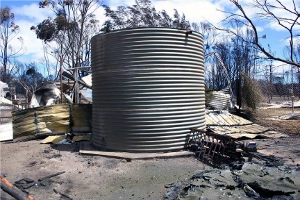Fire Water Tanks
Queensland and NSW Fire-Resistant BAL-Compliant | Australian Made Steel Tanks for Fire-Fighting and Bushfire Protection – BASIX Compatible
What type of water tank is used for fire fighting?
The Fire tanks need to be made from a non-combustible material and have the appropriate firefighting attachment fitted: a 50mm Outlet with a Ball Valve with either the Storz fitting [NSW] or Camlock fitting [Qld], to meet the local council requirements for the BAL Rating on your property.
Metal water tanks are extremely durable because they keep their structural integrity during a bushfire. Researchers from the CSIRO and Monash University have extensively tested the performance of water tanks in bushfires. They found:
Stainless Steel Tanks did not burn or split when fully exposed to fire for over 30 minutes. They became slightly scorched but there was no structural damage and only minor water loss.
Aquaplate (Colorbond) Tanks maintained structural integrity in a fire but when the temperature reached above 65 degrees, the thin plastic lining on the inside of the tank began to delaminate, causing slight water loss.
What Size Tank for Fire Fighting?
Depending on your risk or BAL rating, a minimum reserve amount is also set for your property to comply with the regulations. Some common sizes are the 10,000 litre Fire Tanks and the 20,000 litre Fire Tanks.
If you have a tank larger than the required “Fire Tank reserved amount”, you would need to ensure the outlet supplying water for household/garden needs is positioned higher up the tank, ensuring that the water below this point is reserved specifically for fire-fighting.
Fire Water Tanks for NSW & QLD
Fire Resistant Compliant Materials and Sizes
Please note: not all dimension combinations are available
Tank Options
| Size Options | 10,000L (2400mm Dia x 3500mm H), 20,000L (3300mm Dia x 2350mm H) |
|---|---|
| Material Options | 304 Grade Stainless Steel, Colorbond / AQUAPLATE® |
Description
The BAL Rating System
The BAL Rating system [Bushfire Attack Level] gives guidelines for properties on Bushfire prone land / areas. By doing an assessment on the property and the surrounding area, a BAL rating is worked out for the property. This BAL rating identifies the risk level, so that specific requirements and be identified to meet your BAL rating. Part of these recommendations can be to have a dedicated fire tank [water stored for the sole purpose of firefighting].
The Fire Tank needs to be in an easily accessible position so in an emergency the “Fire fighters” can connect to the tank. On some properties there are specific regulations for where this tank needs to be positioned, we recommend contacting your certifier / builder or local council for site specific information.
BAL Description of risk
- BAL LOW – Lowest risk from a potential fire.
- BAL 12.5 – Risk is primarily from potential embers during a fire.
- BAL 19 – Moderate risk, particularly from embers and burning debris.
- BAL 29 – High risk, particularly from embers, debris, and heat.
Water Tank Delivery Info
Select Water Tank prefers to position the tank on the prepared tank base at delivery time. Above all, we will need clear access and some on-site assistance to manually handle the tank/s. Therefore, should a crane be required, the customer would be responsible for organising it. In summary, we are happy to work together to coordinate delivery times, etc.
Delivery is calculated to your area and considers the tank size, delivery method, and other special requirements.
Estimated Water Tank Delivery Fees
What is O Size? Tanks 2.6m high or round tanks with a 3.7m diameter create an oversized load when transported on the road.
| Distance | Standard | O Size |
| 0-50km | $180 | $220 |
Please contact our team for a quote for distances greater than 50kms or oversized loads.
Fire Water Tankss BAL ratings or BASIX Requirements
With new regulations implemented after past bushfire seasons, the BAL Rating system [Bushfire Attack Level] gives guidelines for properties on Bushfire prone land. Part of these recommendations are to have a dedicated fire tank [water stored for the sole purpose of firefighting].
The tanks can be made to have the Storz fitting [NSW] or Camlock fitting [Qld] installed to meet the local council requirements for the BAL Rating, on your property.
Need a different size?
Custom water tanks are what we do, and we have thousands of different sizes available to suit your requirements.
Generate Your Quote Below
Use the fields below to generate a full quote request. If you are not sure about any of these - just select “Not Sure” and we can confirm with you once we finalise your order
Water Tanks for Bushfire Protection
Proven to Withstand Intense Heat and Safeguard Water Supply
Researchers from the CSIRO and Monash University have conducted extensive testing on the performance of water tanks in bush fires. They found:
Stainless Steel Tanks did not burn or split when fully exposed to fire for over 30 minutes. They became slightly scorched but there was no structural damage and only minor water loss.
For more information see: www.bushfirecrc.com
Aquaplate (Colorbond) Tanks maintained structural integrity in a fire but when the temperature reached above 65 degrees, the thin plastic lining on the inside of the tank began to delaminate, causing slight water loss.
Polyethelene (plastic) Tanks quickly split and collapsed in a fire, emptying themselves and melting down.
Fire Fighting Tanks FAQS
What is the Australian standard for fire water tanks?
The Australian Government has developed the Bushfire Attack Level (BAL) rating system, which gives a rating and recommendations for compliance for individual properties to prevent and defend in the event of a bushfire attack. The Australian standard for fire water tanks is determined by this BAL rating system, and the BAL rating is given to your individual property.
Part of these BAL Rating requirements can be to have a Fire Tank with a reserved amount of water for the purpose of firefighting installed on your property to achieve compliance. This tank needs to be a non-combustible tank, positioned, so it is visible, and that access is not obstructed with the “state appropriate” firefighting fittings to be on the tank, so the
state fire authority/property owners can quickly attach their equipment to the tank to access the stored water.
In some instances, there are also specifications of where the tank needs to be located on the property. Select Water Tanks make non-combustible stainless steel and Colorbond / Aquaplate rainwater tanks to meet the recommendations for the fire tanks for Qld & NSW.
We recommend seeking professional advice from your building certifier, local fire authority or local council about the BAL Rating requirements for your individual property.
What size water tank for fire fighting?
The Australian Government Bushfire Attack Level (BAL) rating system designates the minimum requirements for individual properties once a BAL Rating is determined, so the property is prepared in the event of a bushfire.
The size of the tank required relates to the BAL rating of the property and an estimation of the amount of water required to protect the property under different types of Bushfire attacks.
Your building certifier, local council or local fire authority would be the best people to consult to get information relevant to your individual property requirements.
Which type of tank is preferred for a fire water tank?
The “state appropriate” firefighting fittings need to be on the tank, so the relevant state fire authority / property owners can quickly attach their equipment to the tank to access the stored water. In Queensland, a 50mm outlet with a ball valve needs to have a 50mm Camlock fitting attached and in New South Wales, a 50mm outlet with a ball valve needs to have a 65mm Storz attachment fitted. Select Water Tanks make Stainless Steel and Colorbond / Aquaplate tanks to meet Qld & NSW BAL regulations for the Fire Water Tanks.
As always, please check with your local authorities to confirm the information is correct for your individual circumstances.
How do you calculate fire fighting water tank capacity?
The nominal capacity [volume] of a round water tank is calculated with the following formula.
V=π r 2h [V=Volume , r= Radius, h= height]
To save you the calculations, our pricing / product pages show our individual tank sizes, including the capacity and the dimensions of the tanks. If the size you require isn’t listed, or you have site limitations and want to explore other options, Select Water Tanks can make a rainwater tanks to suit your individual needs. Jump onto our contact page and send us a message.




